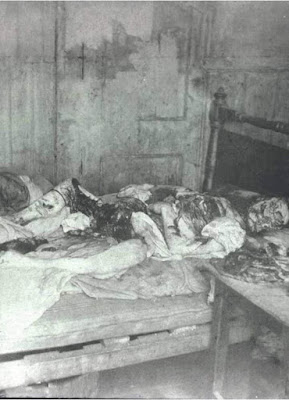THE MURDERS OF JACK THE STRIPPER
He walked the streets of London and killed prostitutes. No, he is not the famous Jack the Ripper, but probably an emule of him: he was nicknamed Jack the Stripper.
Jack the Stripper is the nickname of a serial killer responsible for the so-called "naked murders" which took place in London in the years 1964 and 1965.
The bizarre nickname was clearly given for the methodology very similar to the serial killer that had shocked London in 1888. This killer also attacked street prostitutes, killing between 6 and 8 and of which naked corpses were found around London or in the Thames. The number of victims is not precise, because two of the murders do not correspond to his modus operandi.
The confirmed victims were:
1. Hannah Tailford, 30, was found dead on February 2, 1964 at Hammersmith Bridge. She was strangled and when she was found she was missing several teeth. She except for her stockings, she was completely undressed.
2. Irene Lockwood, 26, was found dead on April 8, 1964 on the bank of the Thames, not far from where Hannah Tailford was found. Kenneth Archibald, a 57-year-old guardian, confessed to this murder nearly three weeks later, but his confession was deemed unreliable due to a discrepancy in his version of events and the finding of the victim.
3. Helen Barthelemy, 22, was found dead on April 24, 1964 in an underpass in Brentford. On the woman's body, fragments of dry paint used in the automotive industry were found. Investigators assumed that the fragments were a clue to the killer's workplace and began researching nearby factories.
4. Mary Flemming, 30, her body was found on July 14, 1964 on a sidewalk in the borough of Chiswick. Fragments of paint were discovered on her body again.
5. Frances Brown, a 21-year-old Edinburgh prostitute, was last seen alive on October 23, 1964 by her friend Kim Taylor, also a prostitute, before she was found dead on November 25. in Kensington. Taylor gave the police a description of a Ford Zephyro, the car she'd given Brown a ride that evening.
6. Bridget O'Hara, 28, of Irish descent, also known as "Bridie", was found dead behind the Heron Trading Estate in a storage shed. Again traces of paint were found.
Alleged victims
1. Elizabeth Figg, 21, was found dead on June 17, 1959, five years before her in Chiswick near the Thames. The circumstances of her death had many similarities to those of the other victims, including the position of her body and death by strangulation.
2. Gwynneth Rees, 22, was found dead in a garbage heap on November 8, 1963. Investigators assumed that Rees may have been a victim of Jack the stripper, as her body was found on the banks of the Thames, strangled. with a rope and without some teeth.
John Du Rose, the investigator in charge of the case from Scotland Yard, interrogated nearly 7,000 suspects. In a press conference he made false statements in an attempt to put pressure on the killer and force him into error: he said that the police had restricted the group of suspects to 3 people. The Stripper did not fall into the trap, but after the conference he did not kill again.
According to some writers of the time, the victims were united, in addition to their work, by the fact that they participated in orgies and pornographic films
They hypothesized that the victims knew each other and that they knew the killer: the killer could be linked to the world of pornography and, fearing being recognized, he would have killed all the witnesses that could lead to him.
Detective Du Rose's most likely suspect was a Scottish-born guardian, Mungo Ireland, who was apparently identified by an elderly lady shortly after the murder of Bridget O'Hara. The paint chips came from the firm where he worked as a gatekeeper, the Heron Trading Estate.
In 1970, Ireland went out of his way to unload his car, leaving a letter to his wife, in which he stated:
\ U0026lt; \ u0026lt; I can no longer bear it ... To help you and for the police who are looking for me, I will be in the garage. >>
The police verified that Ireland, at the time of the O'Hara murder, was in Scotland, so he could not be the Stripper.
In the book Jack of Jumps, writer David Seabrook claimed that Brian Cushway, a former cop, was also a prime suspect, but no definitive evidence was ever found that framed him.
Jimmy Evans and Martin Short in their book "The Survivor" instead claim that the killer was Tommy Butler, of the Metropolitan Police mobile squad.
In short, as for Jack the Ripper, even this killer got away with it and to date we don't have the faintest idea who he was. He is probably still alive, maybe he is a lively old man who, there, in a dark London alley, is waiting to be able to resume his hunt for prostitutes.was











Comments
Post a Comment